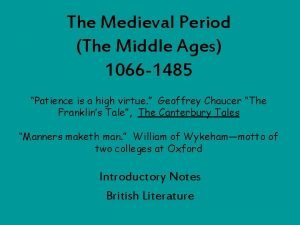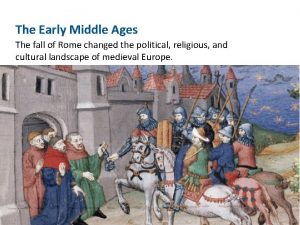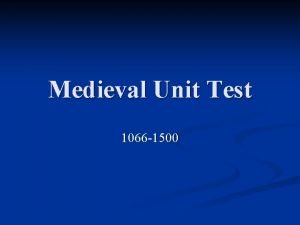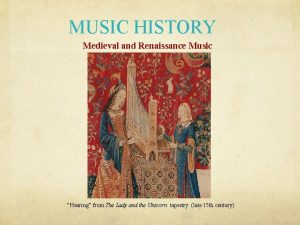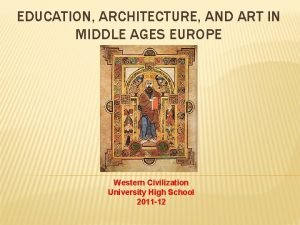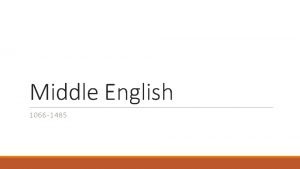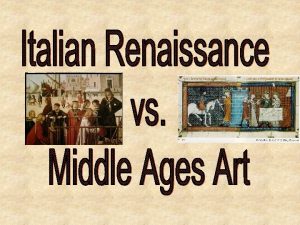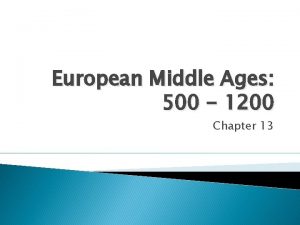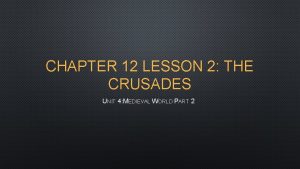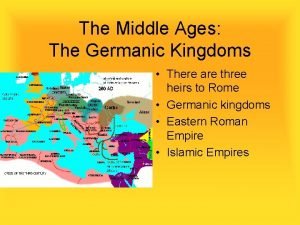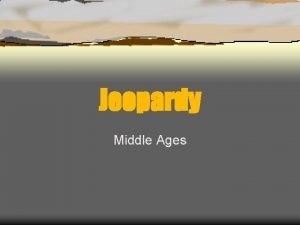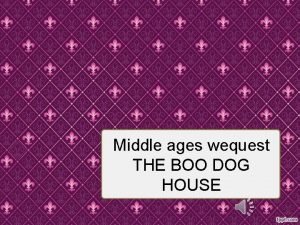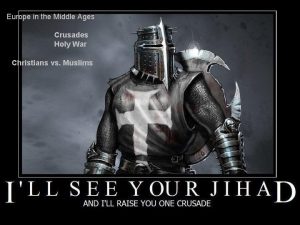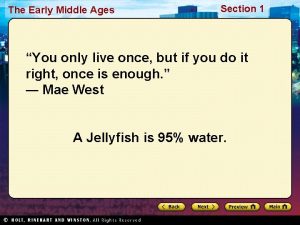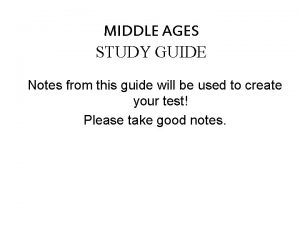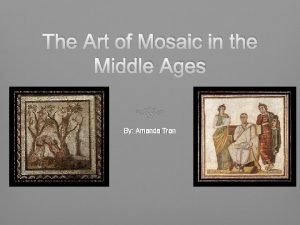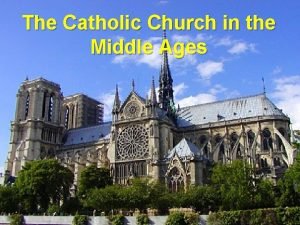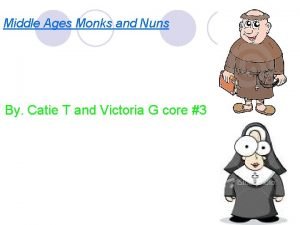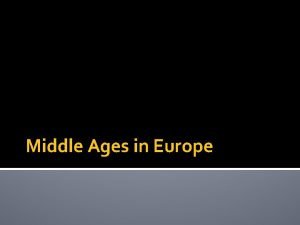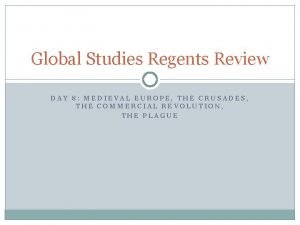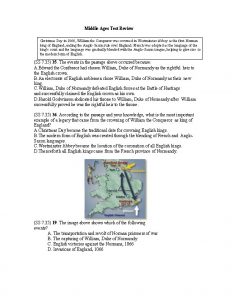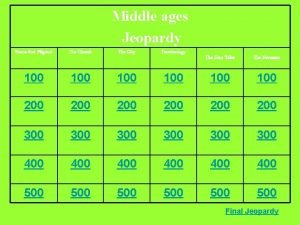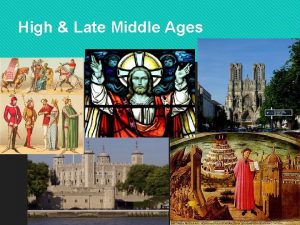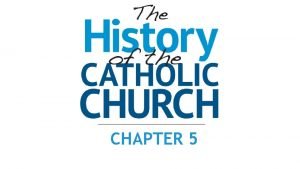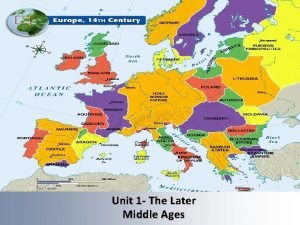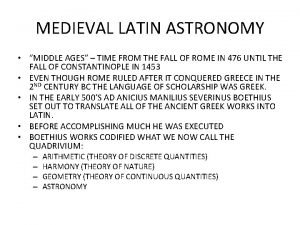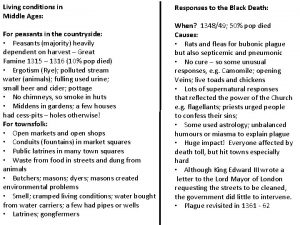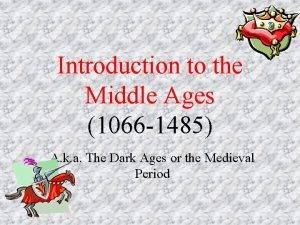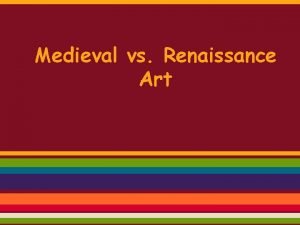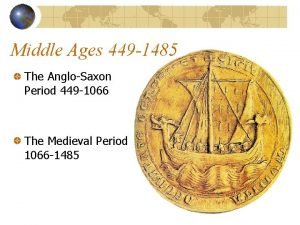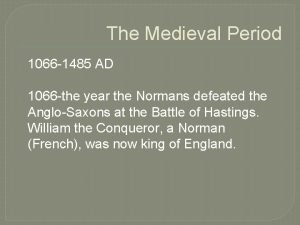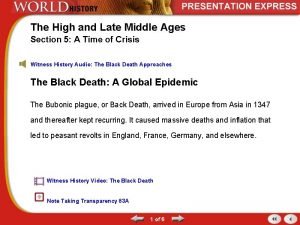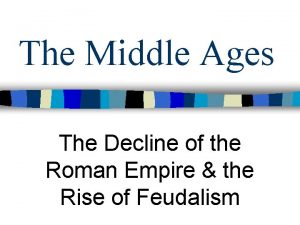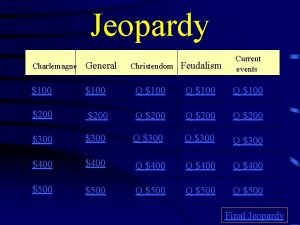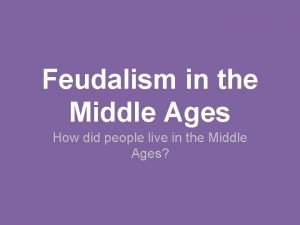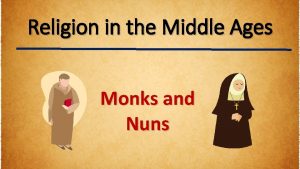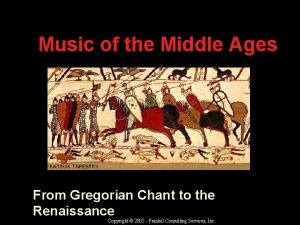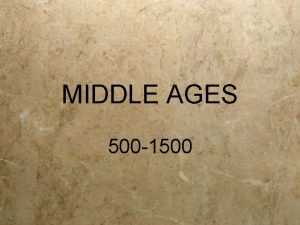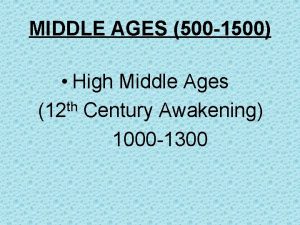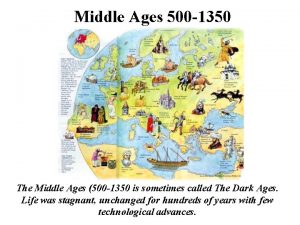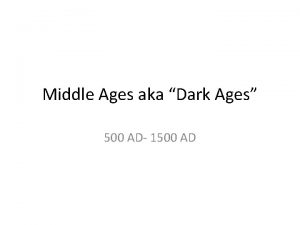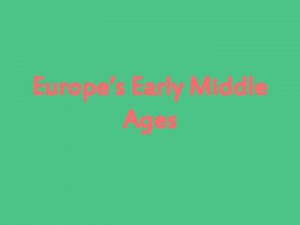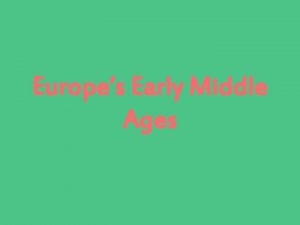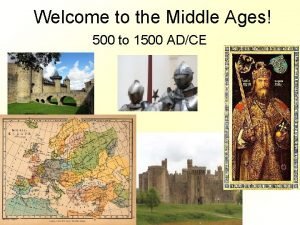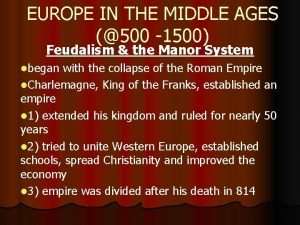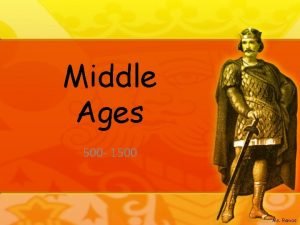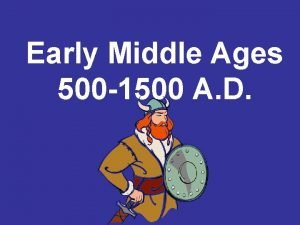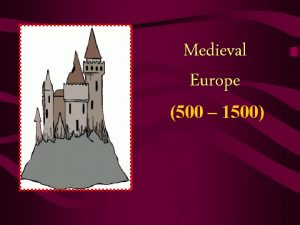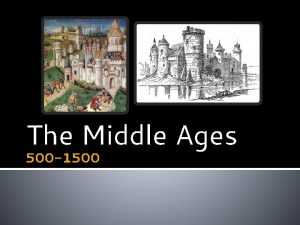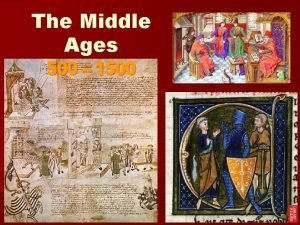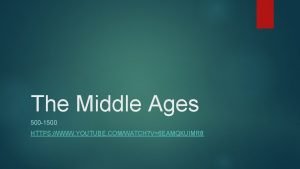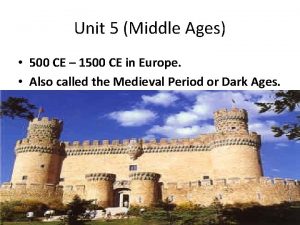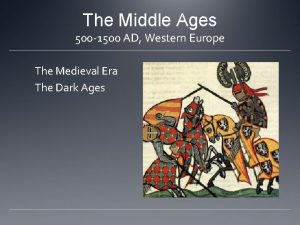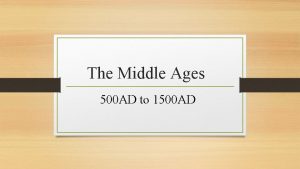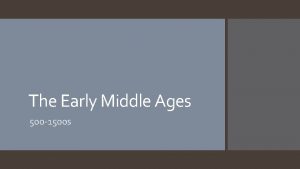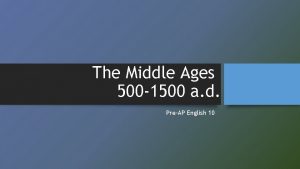Welcome to the Middle Ages 500 to 1500

















































- Slides: 49

Welcome to the Middle Ages! 500 to 1500 AD/CE

What are the Middle Ages? • The decline of the Roman Empire ushered in an era of European history from 500 to 1500. • Also known as the Medieval period • During this time period Europe was fragmented.

How was Europe fragmented? Germanic people invaded Western Europe leading to 1. Disruption of trade 2. Downfall of cities 3. Population shifts (moved to rural areas) 4. Decline in learning 5. Loss of a common language

Hand Profile - Charlemagne What did he do? Why is this important? When? Where? Who?

Who can unite the people? (Answers for the hand profile) • Charlemagne, leader of a Germanic people known as the Franks, came to power • Western Europe • 771 – took over entire kingdom – ranged from modern day Spain to Germany down to Italy - Charlemagne built an empire greater than any since Ancient Rome. • He fought back Muslims in Spain, spread Christianity and supported the Pope • Crowned “Holy Roman Emperor” by the Pope on December 25 th in 800 AD. This set the precedent for the relationship of church and state combined, with the Pope having power over the King.

The Pope (church) claimed the right to crown him Emperor


What happened when Charlemagne died? • His Empire was divided amongst his heirs into three kingdoms (see the map on pg. 321).

As central authority broke down, the lack of strong rulers led to a new system of governing and landholding known as …

• Feudalism – a system of political organization and mutual obligations based on land loyality. • In exchange for military protection and other services, a lord (landowner) granted land called a fief. The person receiving a fief was called a vassal.

FEUDALISM PYRAMID – Sketch this pyramid into your notebook.

MONARCHS • Became weaker after Charlemagne’s death • Remained highest authority LORDS & NOBLES • Lived on manors in castles • Included powerful clergy • Hunted, defended manor, oversaw serfs, & settled legal disputes

KNIGHTS • Trained warriors who studied warfare from the age of 7 • Followed code of chivalry • Exchanged military service for fief (an estate granted by a lord) PEASANTS/SERFS • Freeman paid lord for use of land & could move around • Serfs worked the land for the lord • Serfs were poor & prisoners of the manor

Knights • Knights’ Code of Chivalry: – Displayed courage & valor in combat – Devotion to lord – Respect toward women • Women: – viewed by church as inferior to men – Their status declined in Europe

Who is in this painting?

Manorialism • Manorialism – Economic arrangement based on rights and obligations between a lord and his serfs. The Manor was selfsufficient! • The lord provided serfs with housing, strips of farmland, and protections from bandits. • In return, serfs tended the lord’s lands, cared for his animals and performed other tasks to maintain the estate.

The Manor – Sketch this map into your notebook.

Let’s Review Feudalism and Manorialism.

European vs. Japanese Feudalism – Copy the venn diagram into your notebook. Europe Japan

European vs. Japanese Feudalism • During the same period of time, both the Japanese and the Europeans were utilizing Feudal systems. • Both needed Feudalism to offer some sense of political organization and social structure when there was no one central government.

Feudalism: European vs. Japanese castles (protected manors)

Knights of Europe

Samurai of Japan • The samurai were the members of the military class, the Japanese warriors. • Foremost allegiance is to feudal lord. • Always carried a sword and wore protective armor. • Live by code of honor called bushido.

European vs. Japanese Feudalism • To finish your venn diagram, use information found in your notes and pages 306 -307 (Japanese Feudalism) and pg. 336 summary of European Feudalism.

The Age of Faith – The Role of the Catholic Church during the Middle Ages • During the Middle Ages in Europe, religion was the most important aspect of life. • As a unifying force in Western Europe, it offered all social classes the same path to salvation – everlasting life in heaven. Chartes Cathedral

Politics & the Church • Church mirrored Feudal Society (copy this): King Highest Lords Lesser Lords Squires & Barons Knights Peasants Pope College of Cardinals Patriarchs Bishops Abbots & Priests Monks & Friars

The Church in the Middle Ages • Use Chapters 13 and 14 in the textbook to complete the handout on the Church in the Middle Ages.

Trade, Towns & Finances: • Better farming methods = more food – 3 field system & horses = able to feed more city folks • Guilds: association of people who worked at same occupation – Jews often were the bankers: usury – loans of money. • City government: burghers – town dwellers

Guilds: (like unions) • Craft specialists: Monopolies Master Craftsman Journeyman Apprentice

Revival of Learning: • Scholars & writers: – “university” –meeting of scholars – Development of Vernacular – everyday language or “common language” – Thomas Aquinas: Summa Theologica – religious truths could be proved with logical arguments. – scholastics – used debated issues of the day.

England France Develop

England “Land of the Angles” • Anglos- Germanic tribe, invaded and settled England • Anglo-Saxons and Vikings were united • King Edward died in 1066 and left no heir

Several Claims to the Throne • William Duke of Normandy • Harold Godwinson, eldest son of powerful English family • Harold Hardrada the Viking King of Denmark

Normans • William- Duke of Normandy – Edward’s cousin – Invaded England • Harold – Anglo Saxon – Claimed the throne

Battle of Hastings • Godwinson marches his forces to meet William’s • They meet on Senlac Hill at the Battle of Hastings (click on the picture)

Battle of Hastings • 1066, Anglo Saxons (Harold) fought the Normans (William) • Harold was killed • Normans declared victory, take over England • William becomes the Conqueror

William the Conqueror Takes Control of England • He declares all of England his property • He grants land to barons who swear their loyalty to him • His actions lay the foundation for a strong centralized government

William’s Decendents • Eleanor of Aquitaine married King Henry II of England – Expanded England territory in France • Sons = Richard the Lionhearted, John

Magna Carta “The Great Charter” (click picture) • King John – Raised taxes to pay for wars – Angered nobles • Nobles forced John to sign the Magna Carta in 1215 • First time a king’s power was limited • Guaranteed basic rights to citizens – no taxation without representation, a jury trial, and the protection of the law

Parliament • Legislative group – Nobles and bishops “House of Lords” – Knights and burgesses “House of Commons” • Provided a check to royal power

France • Capetian Dynasty • King Phillip II – Tripled the size of France • King Louis IX – Centralized government • King Phillip IV – Added third estate

Estates General • 1 st Estate- clergy • 2 nd Estate- nobility • 3 rd Estate- commoners

A Century of Turmoil

Challenge to Church Authority • John Wycliffe: in England, translated Bible into English so Pope & clergy were not needed for salvation • Jan Hus: German, burned for supporting Wycliffe’s ideas, 1415 Jan Hus burning at the stake

Bubonic Plague • • Began in Asia Fleas and rats Carried by merchants 1/3 population died, 25 million • Jews were blamed Doctor’s robes for battling the plague (click the picture)

Plague Effects • • • Reduced population Trade declined, prices rose Farms abandoned, serfs seek wages Peasant revolts Church lost prestige – prayer and penance, desertion • Pessimistic attitude Plague art depicting death as a skeleton

Hundred Years’ War • England’s Edward III claimed the throne of France • Fought in France • Battle of Crécy – English won – Longbow and archers • Poitier and Agincourt – Longbow (again) End of chivalric warfare 15 th century miniature of the Battle of Agincourt (click picture)

Joan of Arc • Heard the voice of God – expel the English • Led the French into battle at Orléans, breaking the siege • Captured in battle by the Burgundians, handed to English, then church • Condemned as a witch and heretic, burned at the stake Joan of Arc at the Siege of Orleans

Impact of Hundred Years’ War • Increased power and prestige of French monarch • Nationalism • Strengthened England’s parliament – “power of the purse”
 Renaissance art vs medieval art
Renaissance art vs medieval art Dark ages vs middle ages
Dark ages vs middle ages Middle english period (1066-1500)
Middle english period (1066-1500) Early middle ages
Early middle ages The middle ages 1066-1485 unit test
The middle ages 1066-1485 unit test The middle ages spans nearly one thousand years.
The middle ages spans nearly one thousand years. Cathedral art
Cathedral art High middle ages
High middle ages The middle ages 1066 to 1485 unit introduction
The middle ages 1066 to 1485 unit introduction Renaissance vs middle ages
Renaissance vs middle ages Medieval hierarchy
Medieval hierarchy Lesson 4 the late middle ages
Lesson 4 the late middle ages Germanic kingdoms in the middle ages
Germanic kingdoms in the middle ages Middle ages jeopardy
Middle ages jeopardy During the middle ages noblewomen had
During the middle ages noblewomen had Middle ages
Middle ages Middle ages nobles
Middle ages nobles Middle ages study guide
Middle ages study guide Medieval mosaic art
Medieval mosaic art French baroque floral design
French baroque floral design Similarities between middle ages and renaissance
Similarities between middle ages and renaissance Middle ages
Middle ages Nuns
Nuns Middle ages
Middle ages The middle ages outcome the power of the church
The middle ages outcome the power of the church Manor system def
Manor system def Discuss the art of emerging europe
Discuss the art of emerging europe Byzantine floral history
Byzantine floral history What were two indirect results of the crusades
What were two indirect results of the crusades Middle ages test review
Middle ages test review How is this
How is this Sacred music in the middle ages
Sacred music in the middle ages Language answer
Language answer Late middle ages timeline
Late middle ages timeline High to late middle ages
High to late middle ages Similarities between middle ages and renaissance
Similarities between middle ages and renaissance European middle ages map
European middle ages map Astronomy in medieval times
Astronomy in medieval times Living conditions in the middle ages
Living conditions in the middle ages The middle ages 1066 to 1485 unit test closed book
The middle ages 1066 to 1485 unit test closed book Medieval vs renaissance art
Medieval vs renaissance art A metaphorical phrase used to replace a concrete noun
A metaphorical phrase used to replace a concrete noun The middle ages 1066-1485 unit test
The middle ages 1066-1485 unit test The high and late middle ages section 5 quiz
The high and late middle ages section 5 quiz Middle ages
Middle ages Current events jeopardy
Current events jeopardy Feudal system in the middle ages
Feudal system in the middle ages Naissance renaissance
Naissance renaissance Monks and nuns in the middle ages
Monks and nuns in the middle ages Gregorian chant middle ages
Gregorian chant middle ages


